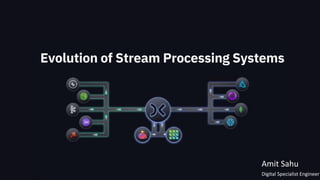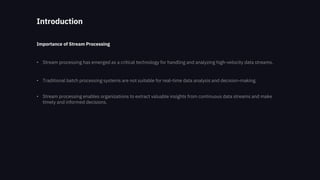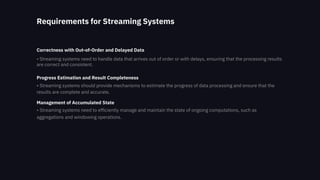Stream Set presentation for datapipeline.
- 1. Evolution of Stream Processing Systems Amit Sahu Digital Specialist Engineer
- 2. Introduction Importance of Stream Processing • Stream processing has emerged as a critical technology for handling and analyzing high-velocity data streams. • Traditional batch processing systems are not suitable for real-time data analysis and decision-making. • Stream processing enables organizations to extract valuable insights from continuous data streams and make timely and informed decisions.
- 3. Introduction Challenges in Stream Processing • Stream processing systems face several challenges in managing out-of-order data, handling stateful computations, ensuring fault tolerance, managing high data loads, and supporting dynamic reconfiguration. • Addressing these challenges is crucial for the successful implementation and adoption of stream processing technology.
- 4. Characteristics of Data Streams and Continuous Queries High-Volume, Real-Time Nature • Data streams are continuous and high in volume, often arriving at a rapid rate. • Continuous queries are executed on these data streams in real-time, requiring immediate processing. On-the-Fly Processing with Limited Memory • Data streams and continuous queries need to be processed on-the-fly, without the ability to store the entire data set. • Limited memory resources pose a challenge for performing computations in real-time.
- 5. Continuously Producing Updated Results • Continuous queries require continuously updated results as new data arrives. • The challenge lies in efficiently updating the query results without reprocessing the entire data stream. Handling High Input Rates • Data streams can have high input rates, making it challenging to process the incoming data in a timely manner. • Efficient mechanisms are required to handle the high input rates and avoid data overload. Characteristics of Data Streams and Continuous Queries
- 6. Requirements for Streaming Systems Correctness with Out-of-Order and Delayed Data • Streaming systems need to handle data that arrives out of order or with delays, ensuring that the processing results are correct and consistent. Progress Estimation and Result Completeness • Streaming systems should provide mechanisms to estimate the progress of data processing and ensure that the results are complete and accurate. Management of Accumulated State • Streaming systems need to efficiently manage and maintain the state of ongoing computations, such as aggregations and windowing operations.
- 7. Requirements for Streaming Systems Fault Tolerance and Failure Handling • Streaming systems should be designed to handle failures gracefully and recover from them without losing data or compromising processing results. Adaptability to Workload Variations • Streaming systems should be able to dynamically adapt to changes in data volume, velocity, and processing requirements to ensure optimal performance and resource utilization.
- 8. Key Concepts and Terms in Stream Processing Data Stream A continuous flow of data records that are generated and processed in real-time. Continuous Query A query that is continuously applied to a data stream, producing real-time results. Out-of-Order Data Data records in a stream that arrive in a different order than they were produced. State The information that a stream processing system maintains about the data it has seen so far.
- 9. Fault-Tolerance The ability of a stream processing system to continue operating correctly in the presence of failures. Load Management The process of efficiently distributing the processing workload across multiple nodes in a stream processing system. Elasticity The ability of a stream processing system to dynamically scale up or down its resources based on the workload. Reconfiguration The process of modifying the structure or behavior of a stream processing system while it is running. Key Concepts and Terms in Stream Processing
- 10. Categorization of Streaming Systems Streaming systems canbecategorized intothreegenerations based on their data model, query language, execution model, and system architecture. These generations represent the evolution of stream processing systems over time.
- 12. Out-of-order Data Management Windowing •Use time-based or count-based windows to group and process data within a specified time or size limit. •Handle out-of-order data by adjusting window boundaries or using watermarking techniques. Ordering •Apply timestamp based or sequence-based ordering to ensure data is processed in the correct order. •Use buffering and buffering techniques to handle late-arriving events. Revision •Maintain a revision history of events to handle late-arriving updates or corrections. •Apply revision logic to update previous results based on new information. Progress Tracking •Use watermarking techniques to track the progress of event processing. •Adjust processing logic based on the current watermark to handle out-of-order events.
- 13. Causes of Disorder Stream processing refers to the real-time processing of data streams. Disorder in stream processing can have various causes, leading to inefficiencies and inaccuracies in data analysis and decision-making. Some common causes of disorder in stream processing include:
- 14. Causes of Disorder Stream processing refers to the real-time processing of data streams. Disorder in stream processing can have various causes, leading to inefficiencies and inaccuracies in data analysis and decision-making. Some common causes of disorder in stream processing include:
- 15. Effects of Disorder Disorderinstream processing can have significant impacts on the efficiency and accuracy of data analysis. When data is not processed in a timely and organized manner, it can lead to various negative effects.
- 16. Effects of Disorder Disorderinstream processing can have significant impacts on the efficiency and accuracy of data analysis. When data is not processed in a timely and organized manner, it can lead to various negative effects.
- 17. State Management Statemanagement is a crucial aspect of stream processing systems as it involves handling and maintaining the state of data streams. In this section, we will explore key aspects of state management in stream processing, including state representation, state partitioning, state persistence, and state scalability. Key Aspects of State Management
- 18. State Management Statemanagement is a crucial aspect of stream processing systems as it involves handling and maintaining the state of data streams. In this section, we will explore key aspects of state management in stream processing, including state representation, state partitioning, state persistence, and state scalability. Key Aspects of State Management
- 20. Fault Tolerance and High Availability Instreamprocessing systems,faulttolerance and high availability are crucial for ensuring continuous data processing and minimizing disruptions. This section examines the key aspects of fault tolerance and high availability in stream processing, including processing semantics, recovery strategies, and availability metrics.
- 21. Load Management, Elasticity, and Reconfiguration Instream processingsystems,loadmanagement,elasticity,andreconfigurationplay crucial roles in ensuring efficient and reliable data processing. This section will discuss key concepts and techniques related to load management, elasticity, and reconfiguration. Load Management Techniques
- 22. Elasticity and Reconfiguration Techniques
- 23. Conclusion Comprehensive Overview The survey provides a comprehensive overview of the fundamental aspects and functionalities of stream processing systems and their evolution over time. Comparison of Early and Modern Systems The paper compares early and modern stream processing systems with regard to their data models, query languages, execution models, and system architectures. Highlighting Important Works The survey highlights important but overlooked works that have influenced today’s streaming systems design. Future Trends and Open Problems The survey discusses future trends and open problems in stream processing, such as supporting multiple time domains, handling cyclic queries, enabling transactional stream processing, and providing user-friendly ways to specify availability. Establishing Common Nomenclature The paper establishes a common nomenclature for streaming concepts, often described by inconsistent terms in different systems and communities.
- 24. THANK YOU























